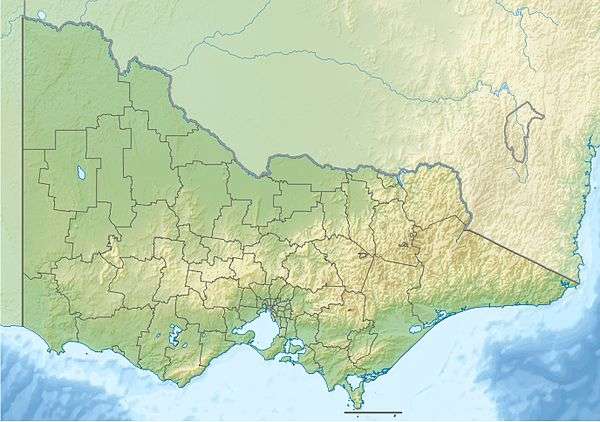Port Campbell National Park
| Port Campbell National Park Victoria | |
|---|---|
|
IUCN category II (national park) | |
|
Port Campbell National Park coastline | |
 Port Campbell National Park | |
| Nearest town or city | Port Campbell |
| Coordinates | 38°39′02″S 143°03′46″E / 38.65056°S 143.06278°ECoordinates: 38°39′02″S 143°03′46″E / 38.65056°S 143.06278°E |
| Established | 5 May 1964[1] |
| Area | 17.5 km2 (6.8 sq mi)[1] |
| Visitation | circa 2,000,000 (in 1998)[1] |
| Managing authorities | Parks Victoria |
| Website | Port Campbell National Park |
| See also | Protected areas of Victoria |
The Port Campbell National Park is a national park in the south-western district of Victoria, Australia. The 1,750-hectare (4,300-acre) national park is situated approximately 190 kilometres (120 mi) south-west of Melbourne and approximately 10 kilometres (6.2 mi) east of Warrnambool. The park is located adjacent to the Great Otway National Park and the Bay of Islands Coastal Park
Features
The Port Campbell National Park features an array of sheer cliffs overlooking offshore islets, rock stacks, gorges, arches, and blow-holes.[2] As part of the Shipwreck Coast,[3] it hosts several tourist attractions; including The Twelve Apostles, the London Arch (formerly London Bridge), Loch Ard Gorge, the Gibson Steps, and The Grotto.
The park is subject to salt-laden air, and the cliff-tops are particularly exposed to the harsh weather conditions from the Southern Ocean. However, fragile grasslands and heath-lands are still able to develop, supporting plant species such as sun orchid and spider orchid. In protected areas, plant life includes beard-heath, bower spinach, coast daisy bush, daisies and cushion bush. The wilder terrain hosts an assortment of she-oaks, dogwoods, correa, messmate, trailing guinea-flower, woolly tea-tree and scented paperbark.[2]
The fauna in the park is largely ornithological; and includes honeyeaters, southern emu and fairy wrens, swamp harriers, rufous bristlebird, peregrine falcons, pelicans, ducks, black swans and egrets. Penguins, terns and dotterels are located along the shoreline, with hooded plovers nesting in exposed locations. Australasian gannets, wandering albatrosses and short-tailed shearwaters live out at sea. Land animals in the park include southern brown bandicoot, swamp antechinuse and echidna.[4]
History
The Port Campbell National Park was dedicated on 5 May 1964,[1] initially with 700 hectares (1,700 acres), in order to protect the limestone formations on and near the coastline adjacent to the Great Ocean Road. By 1981 the park had grown to 1,750 hectares (4,300 acres); extending from the eastern side of Curdies Inlet at Peterborough to Point Ronald at Princetown.[2] In 2002, the Port Campbell Professional Fishermen's Association unsuccessfully attempted to block the creation of a proposed marine national park at the Twelve Apostles location,[5] but were satisfied with the later Victorian Government decision to not allow seismic exploration at the same site by Benaris Energy;[6] believing it would harm marine life.[7]
See also
References
- 1 2 3 4 "Port Campbell National Park and Bay of Islands Coastal Park management plan" (PDF). Parks Victoria (PDF). Government of Victoria. September 1998. pp. 3–5, 26. ISBN 0-7311-3133-9. Retrieved 25 August 2014.
- 1 2 3 "Port Campbell". The Sydney Morning Herald. 8 February 2004. Retrieved 27 May 2010.
- ↑ "A vision splendid". The Sydney Morning Herald. 23 November 2002. Retrieved 17 June 2010.
- ↑ "Port Campbell - Places to See". The Age. Retrieved 17 June 2010.
- ↑ "Port Campbell bid to block marine national park". www.abc.net.au. Australian Broadcasting Corporation. 15 April 2002. Retrieved 17 June 2010.
- ↑ "Fishermen welcome decision against national park seismic exploration". ABC News. Australia. 17 October 2003. Retrieved 17 June 2010.
- ↑ "Otway Basin seismic survey work set to start". ABC News. Australia. 21 October 2003. Retrieved 17 June 2010.
External links
| Wikimedia Commons has media related to Port Campbell National Park. |
- Port Campbell National Park (PDF) (Map). Parks Victoria, Government of Victoria. August 2012.
- "Victoria's Heritage: Port Campbell National Park" (PDF). Parks Victoria (PDF). Government of Victoria.
- "Port Campbell National Park & Bay of Islands Coastal Park: Visitor Guide" (PDF). Parks Victoria (PDF). Government of Victoria. June 2014.